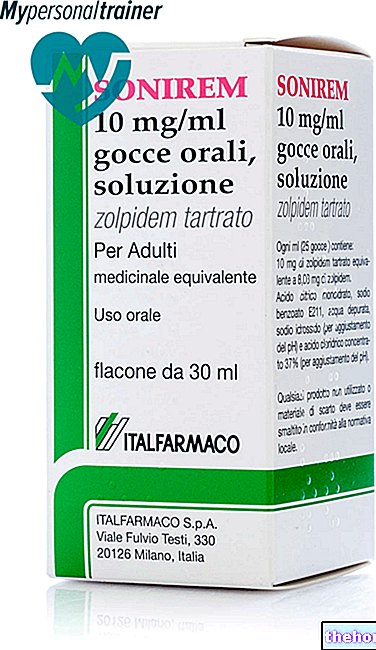Active ingredients: Dexamethasone, Chloramphenicol
CLORADEX 0.2% + 0.5% eye drops, suspension
Why is Cloradex used? What is it for?
Pharmacotherapeutic group
Corticosteroids and antimicrobials in combination.
Therapeutic indications
Non-purulent ophthalmic infections from germs sensitive to chloramphenicol when it is useful to associate the anti-inflammatory action of dexamethasone in particular: bacterial and allergic conjunctivitis, keratitis, inflammation of the anterior segment of the eye, especially post-operative.
Contraindications When Cloradex should not be used
- Hypersensitivity to the active substances or to any of the excipients;
- Intracular hypertension;
- Acute herpes simplex and corneal virus diseases in the acute ulcerative phase, except in associations with specific chemotherapeutic agents for the herpetic virus and in conjunctivitis with ulcerative keratitis even in the initial phase (positive fluorescein test). In viral herpetic keratitis it is not recommended to use it, which can only be allowed under the strict supervision of the ophthalmologist;
- Tuberculosis of the eye;
- Mycosis of the eye;
- Acute purulent ophthalmias, purulent conjunctivitis and purulent and herpetic blepharitis which can be masked or aggravated by corticosteroids;
- Sty.
Precautions for use What you need to know before taking Cloradex
In very early childhood, the product should be administered only in case of real need and under the direct supervision of the doctor.
Interactions Which drugs or foods can modify the effect of Cloradex
Tell your doctor or pharmacist if you have recently taken any other medicines, even those without a prescription.
No particular interactions and incompatibilities with other drugs were found.
Warnings It is important to know that:
During prolonged treatments it is advisable to carry out frequent checks of the ocular tone; Prolonged use can give rise to undesirable effects, such as glaucoma, with consequent damage to the optic nerve, reduction of visual acuity and visual field, and formation of posterior subcapsular cataract, or it can favor the onset of viral ocular infections or bacterial.
Furthermore, prolonged application of steroids over time can favor the development of viral, bacterial and fungal infections of the cornea. It is not advisable to use the drug for a period longer than a month without medical supervision.
Steroid therapy in the treatment of stromal herpes simplex requires great attention and rigorous monitoring and frequent specialist follow-up is required.
Since cases of corneal perforation have been described with the use of steroids, careful monitoring must be carried out in diseases that generate thinning of the cornea and sclera.
The safety of intensive or prolonged topical steroid therapy during pregnancy has not been fully established.
Prolonged topical use of antibiotics can lead to the development of resistant microorganisms; if this occurs or clinical improvement is not noted after 7-10 days, the doctor should be consulted.
The product, if accidentally ingested or if used for a long time in excessive doses, can cause toxic phenomena.
Rare cases of bone marrow hypoplasia have been described following prolonged use of topical chloramphenicol. For this reason, the product should be used for short periods, unless explicitly indicated by the doctor.
Pregnancy and breastfeeding
Ask your doctor or pharmacist for advice before taking any medicine.
In pregnant or breastfeeding women, it is advisable to administer the product only in cases of real need and under the direct supervision of the doctor, only if the expected benefit for the mother is considered greater than the risk for the fetus. intensive and prolonged therapies based on topical steroids in pregnancy was not highlighted.
Effects on ability to drive and use machines
Cloradex does not affect the ability to drive or use machines.
The 5 ml pack contains thiomersal: it can cause allergic reactions.
Dose, Method and Time of Administration How to use Cloradex: Posology
1 or 2 drops in the conjunctival sac, 3 to 5 times a day, according to medical prescription.
Overdose What to do if you have taken too much Cloradex
No cases of overdose have been reported.
In case of accidental ingestion / intake of an excessive dose of Cloradex, notify your doctor immediately or go to the nearest hospital.
IF IN ANY DOUBT ABOUT USING CLORADEX, CONTACT YOUR DOCTOR OR PHARMACIST.
Side Effects What are the side effects of Cloradex
Like all medicines, CLORADEX can cause side effects, although not everybody gets them.
Sometimes, a sense of burning, irritation and phenomena of individual hypersensitivity of different types can occur locally towards the components of the product, which require the interruption of the treatment and the adoption of adequate therapeutic measures.
Undesirable effects from systemic absorption of the active substances are unlikely. Keep in mind, especially for prolonged treatments over time at high doses, the risk of bone marrow hypoplasia due to chloramphenicol and the occurrence of undesirable effects for high amounts of steroids.
Compliance with the instructions contained in the package leaflet reduces the risk of undesirable effects.
If any of the side effects gets serious, or if you notice any side effects not listed in this leaflet, please inform your doctor or pharmacist.
Expiry and Retention
Expiry: see the expiry date printed on the package.
The expiry date refers to the product in intact packaging, correctly stored.
WARNING: Do not use the medicine after the expiry date shown on the package.
Shake before using.
Keep in the fridge.
5 ml bottle: the product should not be used more than 15 days after first opening the container.
0.4 ml single-dose container: the product does not contain preservatives. After opening the container, the product must be administered and the single-dose container must be discarded even if only partially used.
Medicines should not be disposed of via wastewater or household waste. Ask your pharmacist how to dispose of medicines you no longer use. This will help protect the environment.
KEEP OUT OF THE REACH AND SIGHT OF CHILDREN.
Other information
Composition
Cloradex 0.2% + 0.5% eye drops, suspension - bottle of 5 ml
1 ml of solution contains 2.0 mg of dexamethasone and 5.0 mg of chloramphenicol.
Excipients: Polyethylene glycol 300, Polyethylene glycol 1500, Polyethylene glycol 4000, Boric acid Sodium borate, Polyoxyethylene sorbitan monoleate, Hydroxypropylmethylcellulose 2910, Sodium ethylmercury thiosalicylate, Purified water.
Cloradex 0.2% + 0.5% eye drops, suspension - 0.4 ml single-dose containers
1 ml of solution contains 2.0 mg of dexamethasone and 5.0 mg of chloramphenicol.
Excipients: Polyethylene glycol 300, Polyethylene glycol 1500, Polyethylene glycol 4000, Boric acid, Sodium borate, Polyoxyethylene sorbitan monoleate, Hydroxypropyl methylcellulose 2910, Purified water.
Pharmaceutical form and content
Eye drops, suspension.
Packs of 1 bottle of 5 ml and 20 single-dose containers of 0.4 ml.
Source Package Leaflet: AIFA (Italian Medicines Agency). Content published in January 2016. The information present may not be up-to-date.
To have access to the most up-to-date version, it is advisable to access the AIFA (Italian Medicines Agency) website. Disclaimer and useful information.
01.0 NAME OF THE MEDICINAL PRODUCT
CLORADEX
02.0 QUALITATIVE AND QUANTITATIVE COMPOSITION
1 ml of solution contains:
active principles:
• dexamethasone 2.0 mg
• chloramphenicol 5.0 mg
For the full list of excipients, see section 6.1
03.0 PHARMACEUTICAL FORM
Eye drops, suspension.
04.0 CLINICAL INFORMATION
04.1 Therapeutic indications
Non-purulent ophthalmic infections from germs sensitive to chloramphenicol when it is useful to associate the anti-inflammatory action of dexamethasone in particular: bacterial and allergic conjunctivitis, keratitis, inflammation of the anterior segment of the eye, especially post-operative.
04.2 Posology and method of administration
1 or 2 drops in the conjunctival sac, 3 to 5 times a day, according to medical prescription.
04.3 Contraindications
The medicine is contraindicated in case of:
• hypersensitivity to the active substances or to any of the excipients;
• ocular hypertension;
• Acute herpes simplex and viral diseases of the cornea in the acute ulcerative phase, except in associations with specific chemotherapeutic agents for the herpetic virus and in conjunctivitis with ulcerative keratitis even in the initial phase (positive fluorescein test). In viral herpetic keratitis, its use is therefore not recommended and may only be allowed under the strict supervision of the ophthalmologist;
• tuberculosis of the eye;
• mycosis of the eye;
• acute purulent ophthalmias, purulent conjunctivitis and purulent and herpetic blepharitis which can be masked or aggravated by corticosteroids;
• sty.
04.4 Special warnings and appropriate precautions for use
During prolonged treatments it is advisable to carry out frequent checks of the ocular tone. Prolonged use can give rise to undesirable effects, such as glaucoma, with consequent damage to the optic nerve, reduction of visual acuity and visual field, and formation of posterior subcapsular cataract, or it can favor the onset of ocular infections of viral origin or bacterial.
Furthermore, prolonged use of steroids over time can favor the development of viral, bacterial and fungal infections of the cornea. It is not advisable to use the drug for a period longer than a month without medical supervision.
Prolonged topical use of antibiotics can lead to the development of resistant microorganisms; if this occurs or clinical improvement is not noted after 7/10 days, the doctor should be consulted.
Steroid therapy in the treatment of stromal herpes simplex requires great attention and rigorous monitoring and frequent specialist follow-up is required.
Since cases of corneal perforation have been described with the use of steroids, careful monitoring should be carried out in diseases that generate thinning of the cornea or sclera.
The safety of intensive or prolonged topical steroid therapy during pregnancy has not been fully established (see section 4.6).
The product, if accidentally ingested or if used for a long time in excessive doses, can cause toxic phenomena.
Rare cases of bone marrow hypoplasia have been described following prolonged use of chloramphenicol for topical use. For this reason, the product should be used for short periods, unless otherwise indicated by the doctor.
In very early childhood, the product should be administered in cases of real need, under the direct supervision of the doctor.
The 5 ml pack contains thiomersal: it can cause allergic reactions.
04.5 Interactions with other medicinal products and other forms of interaction
None known.
04.6 Pregnancy and breastfeeding
In pregnant or breastfeeding women, it is advisable to administer the product only in cases of real need and under the direct supervision of the doctor, only if the expected benefit for the mother is considered greater than the risk for the fetus. intensive and prolonged therapies based on topical steroids in pregnancy has not been fully established.
04.7 Effects on ability to drive and use machines
Cloradex does not affect the ability to drive or use machines.
04.8 Undesirable effects
Sometimes, a sense of burning, irritation and phenomena of individual hypersensitivity of different types can occur locally towards the components of the product, which require the interruption of the treatment and the adoption of adequate therapeutic measures.
Undesirable effects from systemic absorption of the active substances are unlikely.
Keep in mind, especially for prolonged treatments over time at high doses, the risk of bone marrow hypoplasia due to chloramphenicol and the occurrence of undesirable effects for high amounts of steroids.
04.9 Overdose
No cases of overdose have been reported.
05.0 PHARMACOLOGICAL PROPERTIES
05.1 Pharmacodynamic properties
Pharmacotherapeutic group: corticosteroids and antimicrobials in combination
ATC code: S01CA01
The pharmacodynamic properties can be deduced from the properties of the individual active ingredients:
Dexamethasone
Corticosterone with anti-inflammatory activity 25 times higher than that of hydrocortisone.
It determines a rapid remission of the inflammatory component, whether it determines the pathology or occurs in conjunction with infections. The existing ability to interfere with intraocular tone generally occurs when administered by the ophthalmic route for short periods (less than a month), as required by the therapeutic indications of the drug Cloradex.
Chloramphenicol
Broad spectrum antibiotic. Acts on gram-negative and gram-positive germs, with bacteriostatic activity. It has low bacterial resistance. It has low toxicity when administered by the ophthalmic route and is well tolerated by the eye tissues.
05.2 Pharmacokinetic properties
The pharmacokinetics of corticosteroids for the treatment of ocular inflammatory processes is known and widely documented. Similarly, the pharmacokinetic properties of chloramphenicol are well known, being an antibacterial agent commonly used in ophthalmology. Cloradex is administered directly into the conjunctival sac. It is known that, following ophthalmic administration, chloramphenicol and dasamethasone are absorbed in the cornea and penetrate into the aqueous humor.
05.3 Preclinical safety data
The acute toxicity tests carried out by oral administration on both mice and rats, relating to a formulation of Chloramphenicol made more complex due to the presence of nitrofurazone and phenylephrine hydrochloride, gave the following LD50 values:
• 1.15 (1.02 - 1.29) in the mouse
• 7.56 (6.45 - 8.64) in the rat
The tests of tolerability and general toxicity carried out on albino rabbits did not show significant differences between the values detected in the animals treated with the product and those treated with placebo.
06.0 PHARMACEUTICAL INFORMATION
06.1 Excipients
5 ml bottle
Polyethylene glycol 300, Polyethylene glycol 1500, Polyethylene glycol 4000, Boric acid Sodium borate, Polyoxyethylene sorbitan monoleate, Hydroxypropyl methylcellulose 2910, Sodium ethylmercury thiosalicylate, Purified water.
Single-dose containers of 0.4 ml
Polyethylene glycol 300, Polyethylene glycol 1500, Polyethylene glycol 4000, Boric acid, Sodium borate, Polyoxyethylene sorbitan monoleate, Hydroxypropyl methylcellulose 2910, Purified water.
06.2 Incompatibility
Not relevant.
06.3 Period of validity
5 ml bottle: 18 months.
Validity after first opening: 15 days
Single-dose containers of 0.4 ml: 2 years.
06.4 Special precautions for storage
Keep in the fridge.
Keep the product in the original packaging.
06.5 Nature of the immediate packaging and contents of the package
5 ml bottle
Low density polyethylene bottle equipped with low density polyethylene dropper and polypropylene cap with screw closure.
Single-dose containers of 0.4 ml
Single-dose low-density polyethylene containers assembled in 5-unit strips.
Pack of 20 single-dose containers.
06.6 Instructions for use and handling
Single-dose containers of 0.4 ml
Before use, make sure that the single-dose container is intact.
Detach the single-dose container from the strip and open by rotating the top without pulling.
Avoid letting the tip of the container come into contact with the eye or any other surface.
Unused medicine and waste derived from this medicine must be disposed of in accordance with local regulations.
07.0 MARKETING AUTHORIZATION HOLDER
TUBILUX PHARMA S.p.A.
Via Costarica 20/22 - 00040 Pomezia (RM)
08.0 MARKETING AUTHORIZATION NUMBER
Cloradex 0.2% + 0.5% eye drops, suspension - bottle of 5 ml - AIC n. 018155046
Cloradex 0.2% + 0.5% eye drops, suspension - 0.4 ml single-dose containers - AIC n. 018155061
09.0 DATE OF FIRST AUTHORIZATION OR RENEWAL OF THE AUTHORIZATION
Cloradex 0.2% + 0.5% eye drops, suspension - 5 ml bottle: 14.06.93 / 31.05.05
Cloradex 0.2% + 0.5% eye drops, suspension - 0.4 ml single-dose containers: 09/09/2009
10.0 DATE OF REVISION OF THE TEXT
09/09/2009




























